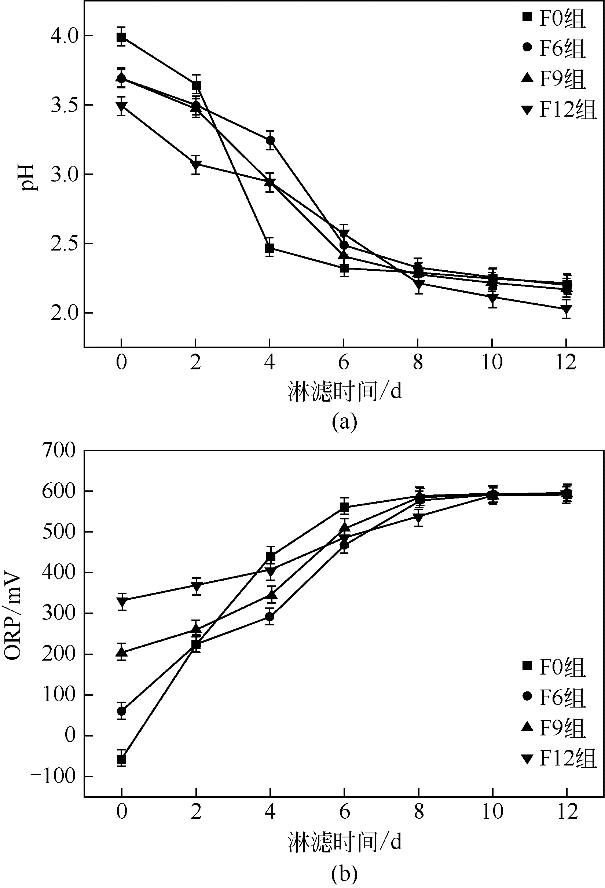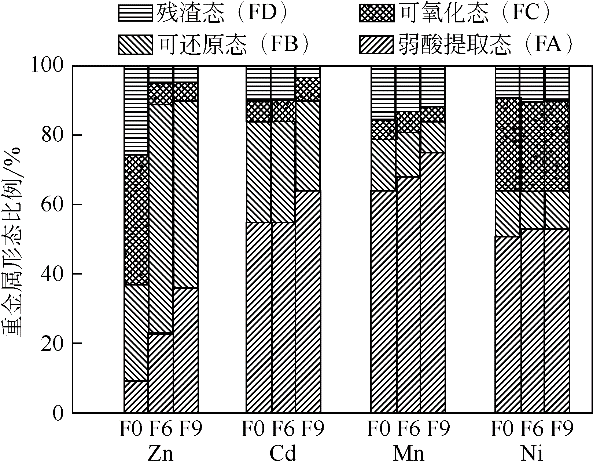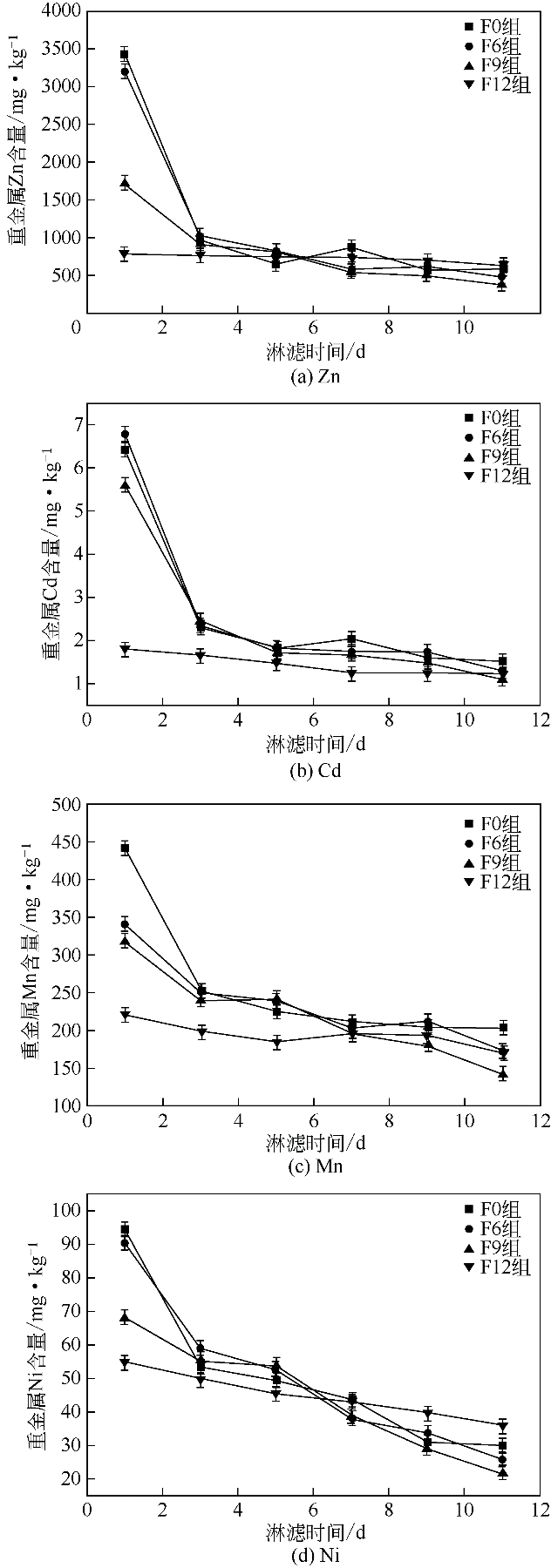Chemical Industry and Engineering Progress ›› 2020, Vol. 39 ›› Issue (2): 805-811.DOI: 10.16085/j.issn.1000-6613.2019-0844
• Resources and environmental engineering • Previous Articles
Effects of Fenton treatment on sewage sludge dewaterability, heavy metal speciation and leaching efficiency
Jinxin ZHENG1( ),Chunsheng QIU1,2(
),Chunsheng QIU1,2( ),Chenchen WANG1,2,Nannan LIU1,2,Dong WANG1,2,Shaopo WANG1,2,Liping SUN1,2,Yifan ZHANG3
),Chenchen WANG1,2,Nannan LIU1,2,Dong WANG1,2,Shaopo WANG1,2,Liping SUN1,2,Yifan ZHANG3
- 1.School of Environmental and Municipal Engineering, Tianjin Chengjian University, Tianjin 300384, China
2.Tianjin Key Laboratory of Aquatic Science and Technology, Tianjin 300384, China
3.Tianjin Capital Environmental Protection Group Company Limited, Tianjin 300381, China
-
Received:2019-05-26Online:2020-03-12Published:2020-02-05 -
Contact:Chunsheng QIU
Fenton处理对污泥脱水性、重金属形态及生物淋滤效率影响
郑金鑫1( ),邱春生1,2(
),邱春生1,2( ),王晨晨1,2,刘楠楠1,2,王栋1,2,王少坡1,2,孙力平1,2,张轶凡3
),王晨晨1,2,刘楠楠1,2,王栋1,2,王少坡1,2,孙力平1,2,张轶凡3
- 1.天津城建大学环境与市政工程学院,天津 300384
2.天津市水质科学与技术重点实验室,天津 300384
3.天津创业环保集团股份有限公司,天津 300381
-
通讯作者:邱春生 -
作者简介:郑金鑫(1995—),男,硕士研究生,研究方向为废弃物资源化。E-mail:17865163996@163.com 。 -
基金资助:水体污染控制与治理科技重大专项(2017ZX07106001);天津市教委科研计划(2016CJ07);天津市企业科技特派员项目(18JCTPJC59600)
CLC Number:
Cite this article
Jinxin ZHENG,Chunsheng QIU,Chenchen WANG,Nannan LIU,Dong WANG,Shaopo WANG,Liping SUN,Yifan ZHANG. Effects of Fenton treatment on sewage sludge dewaterability, heavy metal speciation and leaching efficiency[J]. Chemical Industry and Engineering Progress, 2020, 39(2): 805-811.
郑金鑫,邱春生,王晨晨,刘楠楠,王栋,王少坡,孙力平,张轶凡. Fenton处理对污泥脱水性、重金属形态及生物淋滤效率影响[J]. 化工进展, 2020, 39(2): 805-811.
share this article
Add to citation manager EndNote|Ris|BibTeX
URL: https://hgjz.cip.com.cn/EN/10.16085/j.issn.1000-6613.2019-0844
| 参数 | 数值 |
|---|---|
| TS/g·L-1 | 85.80 |
| VS/g·L-1 | 43.33 |
| pH | 6.80 |
| Zn含量/mg·kg-1 | 3451.52 |
| Cd含量/mg·kg-1 | 6.45 |
| Mn含量/mg·kg-1 | 443.40 |
| Ni含量/mg·kg-1 | 94.96 |
| 参数 | 数值 |
|---|---|
| TS/g·L-1 | 85.80 |
| VS/g·L-1 | 43.33 |
| pH | 6.80 |
| Zn含量/mg·kg-1 | 3451.52 |
| Cd含量/mg·kg-1 | 6.45 |
| Mn含量/mg·kg-1 | 443.40 |
| Ni含量/mg·kg-1 | 94.96 |
| 名称 | Zn | Cd | Mn | Ni | ||||
|---|---|---|---|---|---|---|---|---|
| k/d-1 | R2 | k/d-1 | R2 | k/d-1 | R2 | k/d-1 | R2 | |
| F0 | 0.0705 | 0.8116 | 0.0491 | 0.9119 | 0.0267 | 0.8389 | 0.0808 | 0.9233 |
| F6 | 0.0921 | 0.8953 | 0.0603 | 0.8540 | 0.0485 | 0.9661 | 0.1045 | 0.9781 |
| F9 | 0.1105 | 0.9641 | 0.0882 | 0.9209 | 0.0673 | 0.9203 | 0.1245 | 0.9575 |
| F12 | 0.0218 | 0.8777 | 0.0393 | 0.9704 | 0.0200 | 0.8387 | 0.0392 | 0.9949 |
| 名称 | Zn | Cd | Mn | Ni | ||||
|---|---|---|---|---|---|---|---|---|
| k/d-1 | R2 | k/d-1 | R2 | k/d-1 | R2 | k/d-1 | R2 | |
| F0 | 0.0705 | 0.8116 | 0.0491 | 0.9119 | 0.0267 | 0.8389 | 0.0808 | 0.9233 |
| F6 | 0.0921 | 0.8953 | 0.0603 | 0.8540 | 0.0485 | 0.9661 | 0.1045 | 0.9781 |
| F9 | 0.1105 | 0.9641 | 0.0882 | 0.9209 | 0.0673 | 0.9203 | 0.1245 | 0.9575 |
| F12 | 0.0218 | 0.8777 | 0.0393 | 0.9704 | 0.0200 | 0.8387 | 0.0392 | 0.9949 |
| 33 | 闫瑾. 生物淋滤法去除污泥中重金属的工艺参数优选研究[D]. 太原: 太原理工大学, 2010. |
| YAN J. Optimization of process parameters for removal of heavy metals from sludge by biological leaching [D]. Taiyuan: Taiyuan University of Technology, 2010. | |
| 34 | 肖凌鹏, 张盼月, 张玉璇, 等. 生物淋滤改善城市污泥的脱水性能[J]. 环境工程学报, 2012, 6(8): 2793-2797. |
| XIAO L P, ZHANG P Y, ZHANG Y X, et al. Improvement of sewage sludge dewatering by bioleaching[J]. Chinese Journal of Environmental Engineering, 2012, 6(8): 2793-2797. | |
| 35 | LI X Y, YANG S F. Influence of loosely bound extracellular polymeric substances (EPS) on the flocculation, sedimentation and dewaterability of activated sludge[J]. Water Research, 2007, 41(5): 1022-1030. |
| 36 | ZHANG W, YANG P, YANG X, et al. Insights into the respective role of acidification and oxidation for enhancing anaerobic digested sludge dewatering performance with Fenton process[J]. Bioresource Technology, 2015, 181: 247-253. |
| 37 | 宋相国. 生物酸化联合类Fenton氧化去除城市污泥中重金属[D]. 长沙: 湖南大学, 2008. |
| SONG X G. Heavy metal removal from sewage sludge by bioacidification and Fenton-like oxidation[D]. Changsha: Hunan University, 2008. | |
| 38 | WEI X, HUANG W, LIU D, et al. Bioleaching of heavy metals from pig manure employing indigenous sulfur-oxidizing bacteria: effects of solid content[J]. Water, Air, & Soil Pollution, 2019, 230(2): 39. |
| 1 | 解道雷, 孔慈明, 徐龙乾, 等. 城市污泥中重金属存在形态、去除及稳定化研究进展[J]. 化工进展, 2018, 37(1): 330-342. |
| XIE D L, KONG C M, XU L Q, et al. Developments of the speciation, removal and stabilization of heavy metals in municipal sludge[J]. Chemical Industry and Engineering Progress, 2018, 37(1): 330-342. | |
| 2 | DAVIS R D. Use of sewage sludge on land in the United Kingdom[J]. Water Sci. Technol., 1987, 19: 1-8. |
| 3 | CHAND S, YASEEN M, RAJKUMARI, et al. Application of heavy metal rich tannery sludge on sustainable growth, yield and metal accumulation by Clarysage (Salvia sclarea, L.)[J]. International Journal of Phytoremediation, 2015, 17(12): 1171-1176. |
| 4 | 周邦智, 吕昕, 赵小辉. 剩余污泥中重金属的电动力学修复研究[J]. 环境工程学报, 2011, 5(6): 1401-1404. |
| ZHOU B Z, LÜ X, ZHAO X H. Research on electrokinetic remediation of heavy metals in surplus sludge[J]. Chinese Journal of Environmental Engineering, 2011, 5(6): 1401-1404. | |
| 5 | WANG J Y, ZHANG D S, STABNIKOVA O, et al. Evaluation of electrokinetic removal of heavy metals from sewage sludge[J]. Journal of Hazardous Materials, 2005, 124(1/2/3): 139-146. |
| 6 | YIP T C, YAN D Y, YUI M M, et al. Heavy metal extraction from an artificially contaminated sandy soil under EDDS deficiency: significance of humic acid and chelant mixture[J]. Chemosphere, 2010, 80(4): 416-421. |
| 7 | HUO J Z, WANG Z Z, ZHANG C. The speciation transformation of Cd, Pb in sludge biology leaching[J]. Advanced Materials Research, 2011, 356/357/358/359/360: 157-160. |
| 8 | CHAN L C. Comparison of bioleaching of heavy metals from sewage sludge using iron- and sulfur-oxidizing bacteria[J]. Advances in Environmental Research, 2002, 7(3): 603-607. |
| 9 | 周普雄, 严勰, 余震, 等. 生物淋滤联合类Fenton反应去除污染土壤中重金属的效果[J]. 环境科学, 2016, 37(9): 3576-3581. |
| ZHOU P X, YAN X, YU Z, et al. Performance of bioleaching combined with Fenton-like reaction in heavy metals removal from contaminated soil[J]. Environmental Science, 2016, 37(9): 3576-3581. | |
| 10 | 周顺桂, 周立祥, 黄焕忠. 生物淋滤技术在去除污泥中重金属的应用[J]. 生态学报, 2002, 22(1): 125-133. |
| ZHOU S G, ZHOU L X, HUANG H Z. Removal of heavy metals from sewage sludge by bioleaching[J]. Acta Ecologica Sinica, 2002, 22 (1): 125-133. | |
| 11 | ZHENG G D, GAO D, CHENG T B, et al. Stabilization of nickel and chromium in sewage sludge during aerobic composting[J]. Journal of Hazardous Materials, 2007, 142(1/2): 216-221. |
| 12 | QUEVAUVILLER P, RAURET G, GRIEPINK B. Single and sequential extraction in sediments and soils[J]. International Journal of Environmental Analytical Chemistry, 1993, 51(1/2/3/4): 231-235. |
| 13 | LIU Y G, ZHOU M, ZENG G M, et al. Bioleaching of heavy metals from mine tailings by indigenous sulfur-oxidizing bacteria: effects of substrate concentration[J]. Bioresource Technology, 2008, 99: 4124-4129. |
| 14 | 廖天鹏, 祝星, 祁先进, 等. 铜污泥中重金属形态分布及浸出毒性分析[J]. 化工进展, 2014, 33(3): 762-768. |
| LIAO T P, ZHU X, QI X J, et al. Chemical speciation of heavy metals and leaching toxicity analysis of sludge in copper metallurgy plan[J]. Chemical Industry and Engineering Progress, 2014, 33(3): 762-768. | |
| 15 | PUEYO M, RAURET G, LVCK D, et al. Certification of the extractable contents of Cd, Cr, Cu, Ni, Pb and Zn in a freshwater sediment following a collaboratively tested and optimised three-step sequential extraction procedure[J]. Journal of Environmental Monitoring, 2001, 3(2): 243-250. |
| 16 | 关若楠, 时亚飞, 梁莎, 等. 复合调理脱水污泥热解残渣中重金属形态分布[J]. 环境科学与技术, 2017(3): 74-78. |
| GUAN R N, SHI Y F, LIANG S, et al. Speciation distribution of heavy metals in pyrolysis residue of dewatered sewage sludge after conditioned with the composite conditioners[J]. Environmental Science & Technology, 2017(3): 74-78. | |
| 17 | 王硕, 杨倩倩, 赵庆良, 等. 污泥重金属提取剂浸提效率及经济性比较[J]. 化工进展, 2015, 34(11): 4079-4083, 4088. |
| WANG S, YANG Q Q, ZHAO Q L, et al. Comparative study on the extraction efficiency and economic performance by different agents in the extraction process of heavy metals in sewage sludge[J]. Chemical Industry and Engineering Progress, 2015, 34(11): 4079-4083, 4088. | |
| 18 | LIU H, YANG J, SHI Y, et al. Conditioning of sewage sludge by Fenton’s reagent combined with skeleton builders[J]. Chemosphere, 2012, 88(2): 235-239. |
| 19 | NEYENS E, BAEYENS J. A review of classic Fenton’s peroxidation as an advanced oxidation technique[J]. Journal of Hazardous Materials, 2003, 98(1): 33-50. |
| 20 | 徐大勇, 操沛沛, 乐王旭, 等. Fenton氧化剩余污泥过程重金属迁移及其形态变化[J]. 环境工程学报, 2016, 10(10): 5893-5900. |
| XU D Y, CAO P P, LE W X, et al. Heavy metal migration and speciation changes of residual sludge during the Fenton oxidation processing[J]. Chinese Journal of Environmental Engineering, 2016, 10(10): 5893-5900. | |
| 21 | 洪晨, 邢奕, 司艳晓, 等. 芬顿试剂氧化对污泥脱水性能的影响[J]. 环境科学研究, 2014(6): 615-622. |
| HONG C, XING Y, SI Y X, et al. Influence of Fenton’s reagent oxidation on sludge dewaterability[J]. Research of Environmental Sciences, 2014(6): 615-622. | |
| 22 | 于贺, 邱春生, 王晨晨, 等. Fenton预处理对城市污泥重金属形态及生物淋滤溶出影响[J]. 环境工程学报, 2019, 13(3): 725-731. |
| YU H, QIU C S, WANG C C, et al. Influence of Fenton pretreatment on heavy metal speciation and bioleaching efficiency in municipal sludge[J]. Chinese Journal of Environmental Engineering, 2019, 13(3): 725-731. | |
| 23 | 国家环境保护总局《水和废水监测分析方法》编委会. 水和废水监测分析方法[M]. 4版. 北京: 中国环境科学出版社, 2002. |
| SEPA, Water and wastewater monitoring analysis method[M]. 4th ed. Beijing: China Environmental Science Press, 2002. | |
| 24 | 刘甜田, 何滨, 王亚韩, 等. 改进BCR法在活性污泥样品重金属形态分析中的应用[J]. 分析试验室, 2007, 26(s1): 17-20. |
| LIU T T, HE B, WANG Y H, et al. Application of improved BCR method in the morphological analysis of heavy metals in activated sludge samples[J]. Chinese Journal of Analysis Laboratory, 2007, 26(s1): 17-20. | |
| 25 | BAYAT B, SARI B. Comparative evaluation of microbial and chemical leaching processes for heavy metal removal from dewatered metal plating sludge[J]. Journal of Hazardous Materials, 2010, 174(1/2/3): 763-769. |
| 26 | ZHU Y, ZENG G M, ZHANG P Y, et al. Feasibility of bioleaching combined with Fenton-like reaction to remove heavy metals from sewage sludge[J]. Bioresource Technology, 2013, 142(Complete): 530-534. |
| 27 | 肖鑫. 土著氧化亚铁硫杆菌与土著氧化硫硫杆菌对尾矿重金属生物淋滤作用的研究[D]. 长沙: 湖南大学, 2011. |
| XIAO X. Experimental research of bioleaching of heavy metals from minc tailing by indigenous thiobacillus ferrooxidans and indigenous thiobacillus[D]. Changsha: Hunan University, 2011. | |
| 28 | BOSECKER K. Bioleaching: metal solubilization by microorganisms[J]. FEMS Microbiol. Rev., 1997, 20(3/4): 591-604. |
| 29 | 李娟. Fenton氧化破解城市污泥及生物淋滤处理河道底泥[D]. 长沙: 湖南大学, 2008. |
| LI J. Sewage sludge disintegration by fenton oxidation and river sediment disposal by bioleaching[D]. Changsha: Hunan University, 2008. | |
| 30 | WONG J W C, XIANG L, GU X Y, et al. Bioleaching of heavy metals from anaerobically digested sewage sludge using FeS2 as an energy source[J]. Chemosphere, 2004, 55(1): 101-107 |
| 31 | ZHANG P, ZHU Y, ZHANG G, et al. Sewage sludge bioleaching by indigenous sulfur-oxidizing bacteria: effects of ratio of substrate dosage to solid content[J]. Bioresource Technology, 2009, 100(3): 1394-1398. |
| 32 | 刘昌庚, 张盼月, 蒋娇娇, 等. 生物沥浸耦合类Fenton氧化调理城市污泥[J]. 环境科学, 2015(1): 333-337. |
| LIU C G, ZHANG P Y, JIANG J J, et al. Sewage sludge conditioning by bioleaching combined with Fenton-like oxidation[J]. Environmental Science, 2015(1): 333-337. |
| [1] | BAI Zhihua, ZHANG Jun. Oxidative removal of NO in DTPMPA/Fenton system [J]. Chemical Industry and Engineering Progress, 2023, 42(9): 4967-4973. |
| [2] | ZHENG Xin, JIA Li, WANG Yanlin, ZHANG Jingchao, CHEN Shihu, QIAO Xiaolei, FAN Baoguo. Effect of sewage sludge mixed with coal slime on heavy metal retention characteristics [J]. Chemical Industry and Engineering Progress, 2023, 42(6): 3233-3241. |
| [3] | CHANG Zhankun, ZHANG Chi, SU Bingqin, ZHANG Congzheng, WANG Jian, QUAN Xiaohui. Effect of H2S gaseous substrate on sludge bioleaching treatment efficiency [J]. Chemical Industry and Engineering Progress, 2023, 42(5): 2733-2743. |
| [4] | ZHAO Jiaqi, HUANG Yaji, LI Zhiyuan, DING Xueyu, QI Shuaijie, ZHANG Yuyao, LIU Jun, GAO Jiawei. Characteristics of three-phase products from co-pyrolysis of sewage sludge and PVC [J]. Chemical Industry and Engineering Progress, 2023, 42(4): 2122-2129. |
| [5] | WANG Yibin, FENG Jingwu, TAN Houzhang, LI Liangyu. Research progress on phosphorus speciation transformation and recovery during thermal chemical conversion of municipal sewage sludge [J]. Chemical Industry and Engineering Progress, 2023, 42(2): 985-999. |
| [6] | SUN Qianqian, LIU Zhen, LI Rui, ZHANG Xi, YANG Mingde, WU Yulong. Low temperature hydrothermal coupling of ferrous ion activated persulfate to improve the dewatering performance of waste activated sludge [J]. Chemical Industry and Engineering Progress, 2023, 42(2): 595-602. |
| [7] | PAN Sirui, DENG Wenyi, SU Yaxin. Verification and application of circuit probe method for measuring the liquid film thickness of sewage sludge [J]. Chemical Industry and Engineering Progress, 2023, 42(10): 5538-5547. |
| [8] | XU Hu, GUO Hongkai, CHAI Changsheng, HAO Xiangzhong, YANG Ziyuan, XU Weijun. Carbon fiber materials used for the electrode of electro-Fenton system: a critical review [J]. Chemical Industry and Engineering Progress, 2022, 41(7): 3707-3718. |
| [9] | WANG Siyi, LI Yuehui, GE Yujie, WANG Huanran, ZHAO Lulu, LI Xianchun. Gasification of sewage sludge and its model compounds with NTP-DBD: effect of atmosphere on product distribution and properties [J]. Chemical Industry and Engineering Progress, 2022, 41(4): 2150-2160. |
| [10] | GU Zhipan, YANG Jichun, ZHANG Ye, TAO Leren, LIU Fanhan. Mathematical modelling of water sorption isotherms and thermodynamic properties of municipal sewage sludge [J]. Chemical Industry and Engineering Progress, 2022, 41(2): 998-1008. |
| [11] | LI Hang, YANG Honghui, SHI Bofang, YAN Wei. Research progress on the application of MOFs and their derivatives in heterogeneous Fenton catalysis [J]. Chemical Industry and Engineering Progress, 2022, 41(11): 5811-5819. |
| [12] | LI Yalin, LIU Lei, LI Kunpeng, LIN Kang, DOU Xue, BI Yajie. Preparation of spherical nano-CaO2 and its application in sludge deep-dewatering coupled with electro-osmotic [J]. Chemical Industry and Engineering Progress, 2021, 40(7): 4047-4054. |
| [13] | TANG Qian, FAN Yixin, SU Xin, HUANG Chengsi, SUN Yuwei, GAO Yonghui, WANG Dong. Preparation of N/B/Fe co-doped biochar cathode for degradation of p-nitrophenol [J]. Chemical Industry and Engineering Progress, 2021, 40(7): 4064-4073. |
| [14] | XU Jie, HUANG Qunxing, MENG Xiangdong, GAO Huaping. Effect of calcium-based additive on phosphorus form and bioavailability during hydrothermal carbonization of sewage sludge [J]. Chemical Industry and Engineering Progress, 2021, 40(6): 3507-3514. |
| [15] | Xiaoxi GUO, Pengfei TIAN, Yang SUN, Doudou DING, Jie ZHANG, Yifan HAN. Tertiary treatment of industrial organic wastewater: development of heterogeneous Fenton catalysts [J]. Chemical Industry and Engineering Progress, 2021, 40(2): 605-620. |
| Viewed | ||||||
|
Full text |
|
|||||
|
Abstract |
|
|||||



